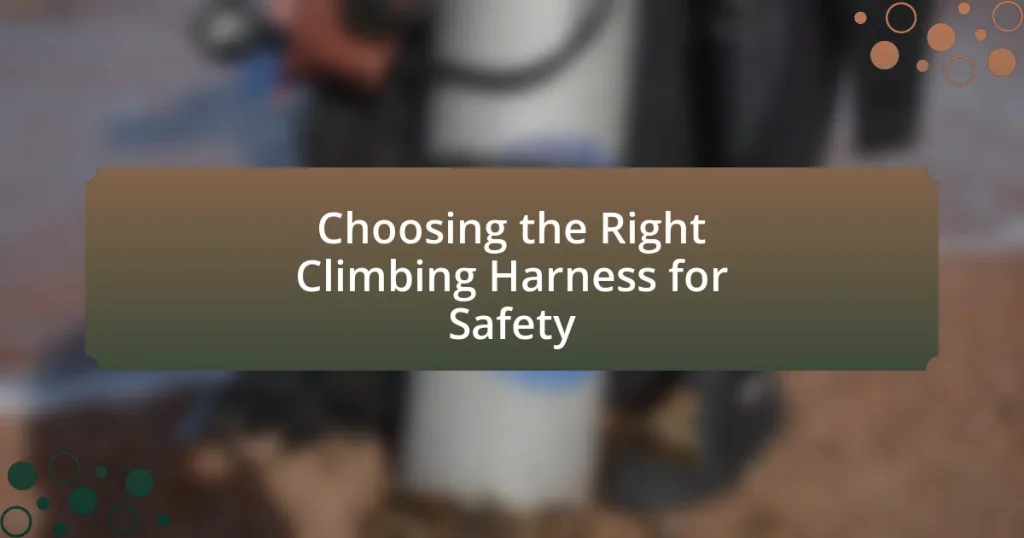A climbing harness is a critical safety device that secures climbers to a rope or anchor system, significantly reducing the risk of injury during falls. This article provides an in-depth examination of climbing harnesses, including their essential components, types, and safety standards. It discusses how to choose the right harness based on climbing style and fit, as well as best practices for usage and maintenance to ensure longevity and safety. Additionally, the article highlights the importance of inspecting harnesses for wear and tear and outlines common mistakes to avoid while using them.

What is a Climbing Harness and Why is it Important for Safety?
A climbing harness is a safety device worn by climbers that secures them to a rope or anchor system, preventing falls and ensuring safety during climbing activities. The importance of a climbing harness for safety lies in its ability to distribute the force of a fall across the body, reducing the risk of injury. According to the American Mountain Guides Association, proper use of a climbing harness can significantly decrease the likelihood of serious injuries in the event of a fall, making it an essential piece of equipment for climbers.
How does a climbing harness function in climbing activities?
A climbing harness functions by securely attaching the climber to a rope or anchor system, distributing weight and forces during falls or while climbing. The harness consists of a waist belt and leg loops, which are designed to fit snugly around the body, ensuring that the climber remains safely connected to the climbing system. When a climber falls, the harness absorbs and distributes the impact forces across the body, reducing the risk of injury. The design and materials used in climbing harnesses, such as nylon and polyester, provide strength and durability, which are essential for safety in climbing activities.
What are the key components of a climbing harness?
The key components of a climbing harness include the waistbelt, leg loops, tie-in points, and gear loops. The waistbelt provides support and distributes weight around the waist, while the leg loops secure the harness around the thighs for stability. Tie-in points, typically reinforced areas at the front of the harness, are where the climbing rope is attached, ensuring safety during climbs. Gear loops are additional features that allow climbers to carry equipment such as carabiners and quickdraws. Each component is designed to enhance safety and functionality, making them essential for effective climbing.
How do these components contribute to safety during climbing?
The components of a climbing harness, such as the waistbelt, leg loops, and gear loops, contribute to safety during climbing by providing secure attachment points and distributing forces evenly in the event of a fall. The waistbelt supports the climber’s weight and prevents slipping, while the leg loops ensure a snug fit, reducing the risk of injury during a fall. Gear loops allow for easy access to essential equipment, enhancing overall climbing efficiency and safety. Research indicates that properly designed harnesses can significantly reduce the risk of injury by effectively managing fall forces, as demonstrated in studies on climbing safety standards.
What types of climbing harnesses are available?
There are several types of climbing harnesses available, including sport climbing harnesses, trad climbing harnesses, mountaineering harnesses, and kids’ harnesses. Sport climbing harnesses are designed for quick adjustments and comfort during single-pitch climbs, while trad climbing harnesses offer more gear loops for multi-pitch routes. Mountaineering harnesses are lightweight and often feature a minimalist design for alpine conditions. Kids’ harnesses are specifically tailored for smaller bodies, ensuring safety and comfort for young climbers. Each type is engineered to meet specific climbing needs and safety standards, ensuring climbers can choose the right harness for their activity.
What are the differences between sport, trad, and alpine harnesses?
Sport harnesses are designed for single-pitch climbing, featuring a lightweight and minimalistic design that prioritizes comfort and ease of use. Trad harnesses, or traditional harnesses, offer more gear loops and padding, catering to multi-pitch climbs where climbers need to carry additional equipment. Alpine harnesses are optimized for cold weather and high-altitude conditions, often being more compact and featuring adjustable leg loops for versatility in layering. Each type of harness serves specific climbing needs, ensuring safety and functionality in different environments.
How do children’s climbing harnesses differ from adult harnesses?
Children’s climbing harnesses differ from adult harnesses primarily in size, design, and safety features. Children’s harnesses are specifically tailored to fit smaller body frames, ensuring a snug and secure fit that accommodates their unique proportions. Additionally, they often include features such as adjustable leg loops and waistbands to allow for growth and comfort. Safety features in children’s harnesses may also include additional padding and reinforced stitching to enhance protection during falls, as children may be more susceptible to injury. These design considerations are crucial, as they ensure that the harness provides adequate support and safety for young climbers, aligning with guidelines from organizations like the American Mountain Guides Association, which emphasizes the importance of proper fit and safety in climbing gear for children.
What safety standards should a climbing harness meet?
A climbing harness should meet safety standards set by organizations such as the American National Standards Institute (ANSI), the International Organization for Standardization (ISO), and the European Committee for Standardization (CEN). These standards ensure that the harness is tested for strength, durability, and safety in climbing scenarios. For instance, ANSI Z359.1 and EN 12277 are specific standards that outline the requirements for harness design, performance, and testing methods, ensuring that the harness can withstand the forces experienced during a fall. Compliance with these standards is crucial for the safety and reliability of climbing equipment.
What organizations set safety standards for climbing harnesses?
Organizations that set safety standards for climbing harnesses include the American National Standards Institute (ANSI), the International Organization for Standardization (ISO), and the European Committee for Standardization (CEN). ANSI develops safety standards in the United States, while ISO provides international standards that ensure quality and safety across various industries, including climbing equipment. CEN establishes safety standards within Europe, ensuring that climbing harnesses meet rigorous safety requirements. These organizations play a crucial role in ensuring that climbing harnesses are tested and certified for safety, thereby protecting users during climbing activities.
How can you verify if a climbing harness meets safety standards?
To verify if a climbing harness meets safety standards, check for certification labels indicating compliance with recognized standards such as the UIAA (International Climbing and Mountaineering Federation) or EN (European Norm) standards. These certifications ensure that the harness has undergone rigorous testing for strength, durability, and safety features. Additionally, review the manufacturer’s specifications and user manuals, which often detail compliance with safety regulations and testing results.

How to Choose the Right Climbing Harness for Your Needs?
To choose the right climbing harness for your needs, assess the type of climbing you will be doing, as different harnesses are designed for specific activities such as sport climbing, trad climbing, or mountaineering. For instance, sport climbing harnesses typically offer more padding and comfort for prolonged use, while trad climbing harnesses may prioritize gear loops and adjustability for versatility. Additionally, consider the harness’s fit, ensuring it is snug but not restrictive, as a proper fit enhances safety and comfort. The weight capacity is also crucial; most harnesses have a maximum weight limit that should be adhered to for safety. Lastly, check for certifications such as UIAA or CE, which indicate that the harness meets safety standards.
What factors should you consider when selecting a climbing harness?
When selecting a climbing harness, consider factors such as fit, type, safety features, and intended use. The fit is crucial because a properly sized harness ensures comfort and safety during climbs; it should be snug but not restrictive. The type of harness, whether it is a sport, trad, or alpine harness, affects its design and functionality, catering to specific climbing styles. Safety features, including gear loops, adjustable leg loops, and padding, enhance usability and comfort, contributing to overall safety. Lastly, the intended use, such as sport climbing, trad climbing, or mountaineering, dictates the necessary specifications and design elements of the harness to ensure it meets the demands of the activity.
How does your climbing style influence your harness choice?
Your climbing style significantly influences your harness choice by determining the features you need for optimal performance and safety. For instance, sport climbers often prefer lightweight, minimalistic harnesses that allow for greater mobility and comfort during dynamic movements, while trad climbers may opt for more padded, versatile harnesses that accommodate gear loops and provide comfort during prolonged hangs. Additionally, alpine climbers typically select harnesses that are durable and can withstand harsh conditions, emphasizing features like adjustable leg loops for layering over clothing. The choice of harness directly correlates with the specific demands of each climbing style, ensuring safety and efficiency in various climbing scenarios.
What role does fit and comfort play in harness selection?
Fit and comfort are critical factors in harness selection, as they directly influence safety and performance during climbing activities. A well-fitting harness distributes weight evenly across the body, reducing pressure points and enhancing mobility, which is essential for maintaining focus and control while climbing. Comfort in a harness also encourages longer wear times, allowing climbers to remain engaged in their activities without distraction from discomfort. Studies indicate that harnesses designed with ergonomic features significantly improve climber satisfaction and performance, underscoring the importance of fit and comfort in ensuring both safety and enjoyment in climbing experiences.
What features should you look for in a climbing harness?
When selecting a climbing harness, prioritize features such as fit, safety ratings, gear loops, and padding. A proper fit ensures comfort and security, while safety ratings, such as those from the UIAA or CE, confirm the harness meets industry standards for strength and durability. Gear loops provide essential attachment points for climbing equipment, and adequate padding enhances comfort during extended use. These features collectively contribute to the harness’s effectiveness and safety during climbing activities.
How do gear loops and padding affect usability?
Gear loops and padding significantly enhance the usability of climbing harnesses by improving organization and comfort. Gear loops provide designated attachment points for climbing equipment, allowing climbers to easily access gear while maintaining a streamlined setup. This organization reduces the risk of gear entanglement and enhances efficiency during climbs. Padding, on the other hand, increases comfort by distributing weight evenly across the body, which is crucial during prolonged use. Research indicates that harnesses with adequate padding can reduce pressure points and fatigue, thereby improving overall performance and safety during climbing activities.
What is the importance of adjustable leg loops?
Adjustable leg loops are crucial for ensuring a secure and comfortable fit in climbing harnesses. They allow users to customize the fit according to their body shape and clothing, which enhances safety by preventing slippage during climbs. A study by the American Alpine Club highlights that a proper fit reduces the risk of injury in falls, as a well-fitted harness distributes forces more evenly across the body. Additionally, adjustable leg loops accommodate varying layers of clothing, making them versatile for different weather conditions and climbing styles.
How can you ensure the right fit for your climbing harness?
To ensure the right fit for your climbing harness, you should first measure your waist and leg sizes accurately, as harnesses are typically sized based on these dimensions. After selecting a harness that corresponds to your measurements, put it on and adjust the straps to achieve a snug fit without restricting movement. A properly fitted harness should allow you to slide two fingers between the harness and your body, ensuring it is secure yet comfortable. Additionally, check that the leg loops are not too tight or too loose, as this can affect safety and comfort during climbing.
What measurements are necessary for proper sizing?
To achieve proper sizing for a climbing harness, the necessary measurements include waist circumference and leg loop circumference. The waist measurement is taken around the narrowest part of the waist, while the leg loop measurement is taken around the thighs at the widest point. Accurate measurements ensure a secure fit, which is critical for safety during climbing activities. According to the Climbing Business Journal, a well-fitted harness can significantly reduce the risk of injury by preventing slippage and ensuring proper weight distribution.
How should a climbing harness feel when worn correctly?
A climbing harness should feel snug but not overly tight when worn correctly. It should distribute weight evenly across the hips and thighs, allowing for comfortable movement without pinching or restricting circulation. The leg loops should fit securely without excessive slack, and the waistbelt should sit above the hips, preventing it from sliding down during use. Proper adjustment ensures that the harness remains in place during climbing activities, enhancing safety and comfort.

What are the Best Practices for Using a Climbing Harness Safely?
The best practices for using a climbing harness safely include ensuring proper fit, double-checking all buckles and knots, and regularly inspecting the harness for wear and tear. A climbing harness should fit snugly around the waist and legs, allowing for movement without being overly loose, as a proper fit prevents slippage during a fall. Before each use, climbers must verify that all buckles are securely fastened and that knots are tied correctly, as this is crucial for maintaining safety during climbs. Additionally, climbers should inspect the harness for any signs of damage, such as fraying or cuts, since using a compromised harness can lead to serious accidents. Following these practices significantly reduces the risk of injury while climbing.
How should you inspect your climbing harness before use?
Inspect your climbing harness before use by checking for any visible signs of wear, damage, or deterioration. Examine the webbing for frays, cuts, or discoloration, as these can indicate compromised strength. Inspect the buckles to ensure they function properly and are free from rust or corrosion. Additionally, verify that all stitching is intact and that the harness fits snugly without excessive looseness. Regular inspections are crucial, as the lifespan of climbing harnesses can be affected by factors such as exposure to UV light and abrasion, which can weaken the material over time.
What signs of wear and tear should you look for?
Signs of wear and tear to look for in a climbing harness include frayed webbing, broken stitching, and signs of abrasion on the fabric. Frayed webbing indicates that the harness may have lost its structural integrity, while broken stitching can compromise the harness’s ability to hold weight. Abrasion marks suggest that the harness has been subjected to excessive friction, which can weaken its material. Regularly inspecting these areas is crucial for ensuring safety during climbing activities, as the harness is a critical component of climbing safety equipment.
How often should you replace your climbing harness?
You should replace your climbing harness every five years, regardless of usage. This recommendation is based on the fact that the materials used in climbing harnesses degrade over time due to exposure to UV light, moisture, and wear and tear. Additionally, if a harness has been involved in a fall or shows signs of significant wear, such as fraying or damage, it should be replaced immediately. The five-year guideline is supported by safety organizations, including the American Mountain Guides Association, which emphasizes the importance of regular inspection and timely replacement to ensure climber safety.
What are the common mistakes to avoid when using a climbing harness?
Common mistakes to avoid when using a climbing harness include improper fitting, neglecting to double-check knots, and failing to inspect the harness before use. An improperly fitted harness can lead to slippage or discomfort, which compromises safety during climbs. Neglecting to double-check knots can result in catastrophic failures, as unsecured knots may come undone under tension. Additionally, failing to inspect the harness for wear and tear can lead to equipment failure, as frayed straps or damaged buckles may not provide adequate support. These mistakes can significantly increase the risk of accidents while climbing.
How can improper use of a harness lead to accidents?
Improper use of a harness can lead to accidents by failing to secure the user adequately, which increases the risk of falls. When a harness is not adjusted correctly, it may not distribute forces evenly across the body, leading to potential injury upon impact. Additionally, if the harness is not properly attached to the climbing system, it can detach during a fall, resulting in serious accidents. According to the American Mountain Guides Association, improper harness usage is a significant factor in climbing accidents, emphasizing the importance of correct fitting and attachment to ensure safety.
What are the best practices for securing your harness before climbing?
The best practices for securing your harness before climbing include ensuring that all buckles are properly threaded and tightened, checking that the harness fits snugly around your waist and legs, and verifying that the harness is free of twists. Additionally, climbers should perform a double-check with a partner to confirm that the harness is secured correctly. These practices are essential because a properly secured harness significantly reduces the risk of accidents during climbing, as evidenced by safety guidelines from organizations like the American Mountain Guides Association, which emphasize the importance of thorough checks to prevent falls.
What tips can enhance your climbing harness experience?
To enhance your climbing harness experience, ensure proper fit and adjustment. A well-fitted harness distributes weight evenly, reducing pressure points and increasing comfort during climbs. According to the American Alpine Club, a harness should be snug but not restrictive, allowing for movement while maintaining safety. Additionally, familiarize yourself with the harness’s features, such as gear loops and belay devices, to maximize functionality. Regularly inspect your harness for wear and tear, as the lifespan of climbing harnesses typically ranges from three to five years, depending on usage and care.
How can you maintain your climbing harness for longevity?
To maintain your climbing harness for longevity, regularly inspect it for signs of wear, such as fraying, cuts, or discoloration. Proper storage is essential; keep the harness in a cool, dry place away from direct sunlight and chemicals that can degrade the material. Additionally, wash the harness with mild soap and water after exposure to dirt or saltwater, ensuring it is thoroughly rinsed and air-dried away from heat sources. Following these maintenance practices can significantly extend the lifespan of the harness, as studies indicate that proper care can prevent premature failure of climbing gear.
What additional gear complements your climbing harness for safety?
Additional gear that complements a climbing harness for safety includes a helmet, climbing shoes, and a belay device. A helmet protects the head from falling debris and impacts, which is crucial in climbing environments. Climbing shoes enhance grip and foot placement, improving overall stability and safety on the rock face. A belay device is essential for managing rope tension and catching falls, ensuring the climber’s safety during ascents and descents. These items collectively enhance safety by addressing various risks associated with climbing activities.
